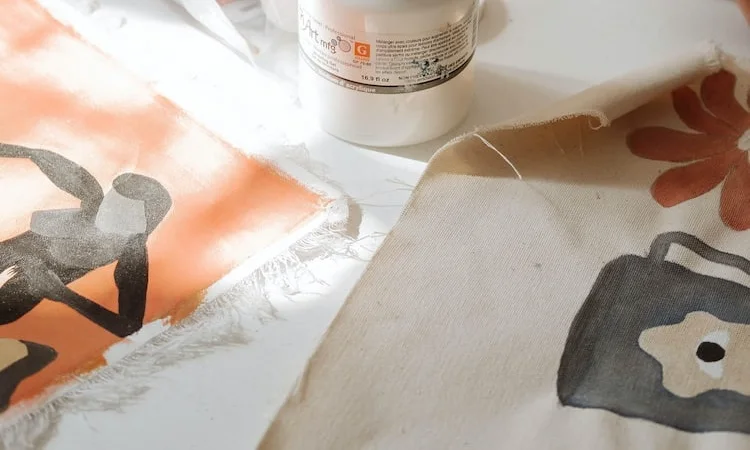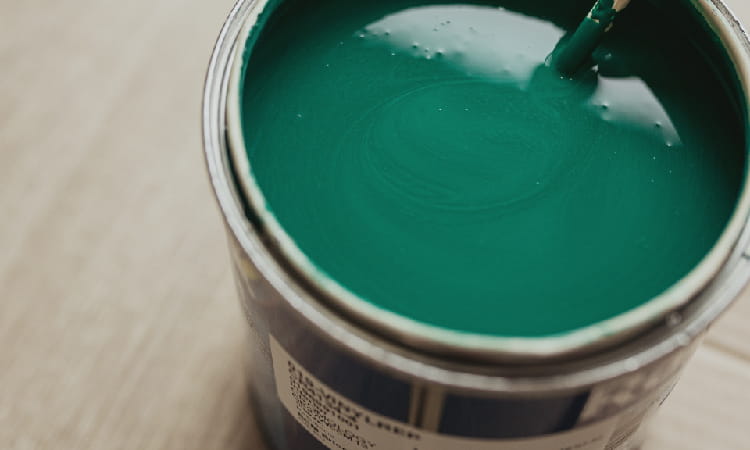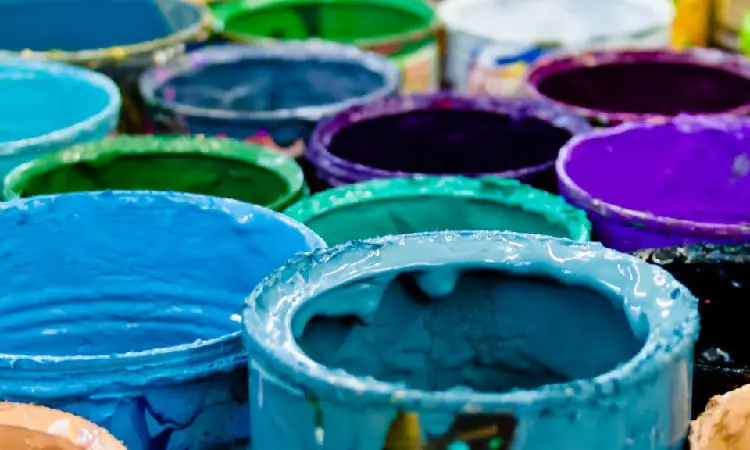You probably know that acrylic paint is one of the most versatile types of paint. Do you have some lying around your house, and you want a new way to use it?
Are you interested in painting fabrics to show off your personality? Then you are probably wondering if you can use acrylic paints on fabrics.
In case you did not know, canvases are a type of fabric. Why would I bring that up?
Well, if you know that canvases are a type of fabric, then you already know acrylic paint can be used on fabrics. But isn’t the fabric of jeans, shoes, and pillows different than canvases?
Yes, it is a different type, but acrylic paint can be used to paint on various kinds of fabric. Acrylic paints can cause fabrics to stiffen.
It can also crack or peel when used on fabrics. You can combat these issues by mixing acrylic paint with a fabric medium.
Keep reading to find out how easy it is to paint fabrics with acrylic paint. I will describe the steps you will need to take when painting.
I will also recommend some of the top acrylic paints on the market.

Can Acrylic Paint Be Used on Fabric?
You can use acrylic paint to paint fabrics, but it can not be used independently. You will need to mix in a medium to allow the paint to adhere to the fabric.
The medium will also thin the paint, which prevents the paint from stiffening when dry. If the paint stiffens, it becomes uncomfortable to wear or use.
Are you wondering why someone would want to paint fabric or what fabrics can even be painted? People paint fabrics as a way to bring life to old or boring clothes, accessories, and decorations.
It is also a great way to show off your personality and style.
Here is a list of common acrylic painting projects:
- Pillows
- Jeans
- Skirts
- Curtains/Tapestries
- Shirts
- Hoodies
- Shoes
Is Acrylic Paint and Fabric Paint the Same?
Technically, they are not. Fabric paint is acrylic paint with a medium already mixed into it. Generally, fabric paint is the best option for painting fabrics.
However, it does not come in a variety of colors. This is why many people will opt for acrylic paint over fabric paint.
You should know that fabric paint does not always work on synthetic fibers.
This is another reason why people choose to use acrylic paint over fabric paint if you are unsure whether your fabric is made of synthetic or natural fibers, you may want to use acrylic paints with a medium.
What is Acrylic Fabric Medium?
I have mentioned mediums a few times, and you are probably wondering what a medium is, right?
A medium essentially turns your normal acrylic paint into paint that will adhere to fabrics.
It makes the once-thick paint very thin and flexible, so it can be easily applied to any fabric.
You should strongly consider purchasing a fabric medium if you want to paint fabrics.
While you can purchase paint specifically designed for fabrics, you will be limited on color options.
Are you worried the medium will alter the color of the paint?
That is a valid worry to have, but the medium will not alter the color. A fabric medium is a non-pigmented liquid.
When you use acrylic paints and add a medium, you open up a variety of additional colors that are not available as specialized fabric paints.
How Do You Prepare Fabric for Acrylic Painting?
You should wash your fabric before painting it. This preparation will remove any debris that is on the shirt.
Some fabrics are also prone to shrinking after the first wash. If you wash the fabric before painting it, then it should not shrink when you wash it later.

This allows your design to be more accurate. If you do not prewash the shirt, it can become morphed when you wash it for the first time after painting it.
You can skip out on using fabric softener during the prewash.
Fabric softener has chemicals that can prevent the paint from adhering to the fabric. You may also want to use a natural laundry detergent. Again, detergents have chemicals in them that can hinder the application of your paint.
What if the Fabric is Wrinkled?
You should iron out any wrinkles before painting. Wrinkles can distort your design and make your painting project more complicated. Read the care instructions on the fabric to determine which iron setting to use.
How to Paint Fabric With Acrylic Paint Step by Step
Are you ready to start painting your fabric? Below I will outline the steps you can take to create your masterpiece.
But first, you should make sure you have all of your materials ready. You should also ensure your work area is covered to protect it from paint.
Pro painter tip: Wear old clothes that you do not mind getting paint on. Even someone with the steadiest hand can slip up.
There is nothing more frustrating than accidentally painting your favorite top or pants.
Materials You Will Need:
- Newspaper or protective sheet covering
- Acrylic paint
- Fabric medium
- Paintbrush(es)
- Cup of water
- Stencil or pencil
Step 1: Pick Your Fabric
You need a fabric to paint! For the best results, you should use a light-color fabric.
It is possible to paint dark fabrics, but it will require significantly more paint. 100% cotton is by far the best fabric to paint on. Again, you can use other fabrics.
A rough fabric will be more difficult to paint compared to a piece of smooth fabric.
You can always try painting in a small area on the fabric to see how the fabric reacts and if it can uphold the paint.
It is recommended to choose a fabric with a tight weave. The tight weaving of fibers will trap the paint color.
This allows more color to be absorbed in your design. If the weaves are loosely strung together, more paint will seep through instead of adhering to the surface.
Step 2: Sketch Your Design or Lay Your Stencil
Suppose you have a stencil. Go ahead and place it now. If you are not using a stencil, now is the time to sketch your design.
This is not a necessary step, but it is highly recommended. Sketching your design allows you to see what it will look like in real life.
You may find that you love the design, or you may want to make tweaks to it. For light-colored fabrics, you can easily use a pencil to create your sketch.
If you are using a dark-colored fabric, you can try pastel chalk to sketch your design.
Step 3: Prepare Your Paint
Before you begin painting, you need to get your paint ready. Most fabric mediums will have instructions on which proportions to use.
Generally, you will use 1 part fabric medium to 2 parts acrylic paint. Be sure to read the instructions, as some mediums require different proportions.
If you mix paint colors, you should do so before adding the medium. Once the medium is added to the paint, simply mix it until you have no lumps present.
Step 4: Paint Your Fabric
Now the fun can finally begin. It’s time to start painting your fabric! You should start with your darker colors and work your way toward lighter colors.
It may be a good idea to let the paint dry in between colors. This can help prevent your colors from running and blending.
Pro tip: Lay cardboard or a divider under the layer you are painting. The paint can be watery and may run through to the other side.
For instance, if you are going to paint the front of a t-shirt, lay cardboard on the inside of the shirt. This will keep the paint from running onto the backside.
Step 5: Time to Dry
This may be the most important step. Acrylic paint is water-based therefore if it is washed before it is dry, it may come off.
You should let the fabric dry for at least 24 hours in a well-ventilated room before you move the fabric.
This allows time for the paint to dry adequately and not run when you maneuver it. Some people will even recommend letting the fabric dry for up to 4 or 5 days before washing it.
Keep reading for information later on how to wash your newly painted fabric.
How Do You Seal Acrylic Paint on Fabric?
The best way to seal acrylic paint on fabric is to use a medium. You can also use heat to seal and set the paint. The heat from an iron can seal the paint.
The paint should dry for at least 24 hours before ironing it. Make sure you have something between the iron and the fabric when you iron it.
Otherwise, you could get paint on your iron. It is recommended to lay a pressing cloth on the side of the fabric with the paint.
You should fully cover the paint and then flip over the fabric. Now, you can iron from the other side, and you will not risk the paint ruining your iron or ironing board.
To avoid having a paint catastrophe, you should turn off the steam setting on your iron. If the iron is releasing steam, you are getting your design wet.
This can potentially cause the paint to run and mix in ways you do not want.
How Do You Soften Stiff Acrylic Paint on Fabric
Your paint should not be stiff if you use a fabric medium with acrylic paint. It is possible to soften acrylic paint with warm water.
This is not the best idea as you could ruin the paint. Too much water can cause the paint to become too runny, and it will not create a neat design.
It can also cause the paint to be unable to adhere properly to the fabric. On the bright side, you can soften the paint by heat-setting the paint with an iron.
Many of you will probably already do this step, as it also helps to seal the paint. You can use the same steps I previously described.
Can You Wash Fabric Painted With Acrylics?

You can wash fabric that has been painted with acrylics. At a minimum, you should let the paint dry for 24 hours before washing it.
Many people will recommend waiting 4-7 days before washing the fabric as this ensures the paint is dry and settles on the fabric.
It is also recommended to hand wash the fabric for the first several washes. The spin cycle on a washing machine can be too vigorous and damage your paint.
Hand washing also keeps the temperature cooler, as no one wants their hands to be in boiling water.
If you want to wash the fabric in a washing machine, use the gentlest setting possible with cool water.
I highly suggest you wash the fabric by itself the first time you choose to wash it.
This is recommended because the paint will run during the washing process.
Just like you do not wash reds with whites, you should not wash a freshly painted fabric with other items.
Many suggest allowing the fabric to hang dry after the first couple of washes. In the long term, this can help preserve the color. If you cannot hang dry the fabric, you can dry it on a low heat cycle in the drying machine.
Can You Use Acrylic Paint on Fabric Without a Fabric Medium?
It is possible to use acrylic paints on fabric without a fabric medium. This is not a wise decision if you plan on wearing the fabric. Acrylic paint is a thick paint and it will cause the fabric to stiffen, making it uncomfortable to wear.
If you do not plan on wearing the fabric, you do not have to use a fabric medium. This ultimately comes down to style preference.
Do you want your decorative pillow to have a watercolor look or be covered in bright and bold colors?
When a fabric medium is added to acrylic paint, it does not alter the color.
However, it does make the paint more loose and watery. It does this so that the paint does not dry stiffly. It also gives the paint more of a watercolor finish.
It is important to note that dried acrylic paint will crack and flake when bent. You should keep this in mind when painting pillows as they are often sat and leaned on.
You might get away with not using a medium on tapestries, as they are often not moved.
What is a Substitute for Fabric Medium?
You can create a homemade fabric paint medium with water, glycerine, and vinegar.
All you have to do is mix one part vinegar, one part water, and two parts glycerine.
If the mix feels too thick, you can continue adding glycerine until it reaches your desired consistency.
You may see some videos of DIYers using conditioner in their acrylic paint.
This is considered a cheaper alternative since many people already have conditioners in their homes.
However, it is not a favored option among the painting community.
While it may work for some projects, people have found the vinegar and glycerine solution to be the better option. You can try both home remedies and see which one you like best.
What Paint Works Best on Fabric?
Paints designed specifically for fabrics will work best on fabrics.
This is because they already have a medium mixed in them. But you now know how to make fabric paints out of acrylic paints.
Washable paints should be avoided when choosing paint for fabric. You want the paint to adhere to the fabric and not be washed away in the washing machine.
Best Acrylic Paint Sets For Fabrics
You know I have to give you a list of some of the top acrylic paint sets for painting on fabrics. I chose these sets based on their color options and their versatility.
If you do not already have a ton of acrylic paint lying around, one of these sets can help get you started on fabric painting projects.
Caliart Acrylic Paint Set: This set comes with 24 beautiful color options. Each bottle contains 2 oz. of paint.
They are non-toxic paints that are safe for any age.
The best part is that this paint can be used on a variety of surfaces. So if you do not fall in love with painting fabric, you can use this paint for other projects.
Arteza Craft Acrylic Paint: This set contains 20 colors, and each bottle holds 2 oz. of paint.
These paints do contain a fast-drying formula which means they dry faster than other paints. Remember that adding a fabric medium to this paint can affect how fast it dries.
Apple Barrel Set: I have to mention Apple Barrel as they are one of the top brands of craft paint. This set comes in 18 different colors.
The colors are very bold and fun. It is also a non-toxic paint that is great for all ages.
Best Fabric Paint Sets
I know I have mostly been talking about using acrylic paints to paint on fabrics. However, I feel it would be unjust if I did not mention the top fabric paints.
After all, fabric paints are still acrylic paints. They are just specifically designed for fabrics.
Shuttle Art Fabric Paint Set: This amazing set comes in 18 different colors. It also includes a palette, paintbrushes, and stencils. The stencils may be too small for t-shirts, but they will work on shoes, purses, and more.
Magicfly Fabric Paint Set: This set comes with 14 different fast-drying colors.
These colors range from neon to metallic to normal paint colors. This paint is not limited to fabrics. You can also use it on wood, glass, and paper.
Can You Use Fabric Markers Instead of Fabric Paint?
Fabric markers are great because they give you more control over your design.
It is easier to have a steady hand when holding a market versus a paintbrush. However, you should be careful when choosing fabric markers.
Some fabric markers are alcohol-based and not acrylic-based. If the marker is alcohol-based, the paint will bleed.
Have you ever had a pen leak in your shirt or pants pocket? Alcohol-based markers can bleed similarly.
Verdict
Acrylic paint can be used to paint fabrics. However, both the fabric and paint will need to be prepared before painting.
You should wash the fabric without a fabric softener before you ever paint it. You will also need to mix your paint with a fabric medium.
A fabric medium will not change the color of the paint as it is a translucent liquid. Instead, it will soften and thin the paint.
This will allow it to adhere better to fabrics. It is possible to paint fabric without a medium, but it will become stiff and crack when bent.
Now all you have to do is bust out your acrylic paint.
You know, that paint has been collecting dust for the last few years. It’s time to create a beautiful masterpiece and show the world your creativity.





